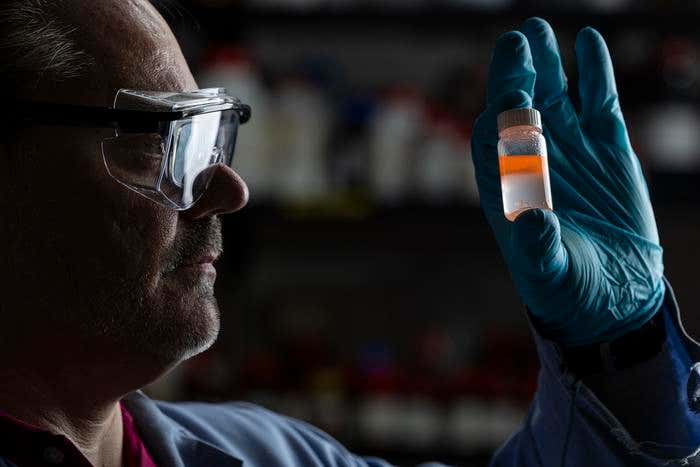Natural solution successfully removes 98% of nanoplastics from water
Researchers at the University of Missouri created a new liquid-based solution that eliminates more than 98% of these microscopic plastic particles from water.

“Our strategy uses a small amount of designer solvent to absorb plastic particles from a large volume of water,” said Gary Baker, an associate professor in University of Missouri’s Department of Chemistry. (CREDIT: Sam O’Keefe/University of Missouri)
Nanoplastics, particles much smaller than the width of a human hair, are increasingly recognized as a threat to human health and the environment. These tiny particles, which are invisible to the naked eye, have been linked to cardiovascular and respiratory diseases and are accumulating in the world's water bodies at an alarming rate. Despite this growing concern, finding a cost-effective way to remove these contaminants from water has been a significant challenge.
At the University of Missouri, researchers have made a breakthrough in addressing this issue. They’ve developed a liquid-based solution that successfully eliminates more than 98% of nanoplastics from water, offering a promising new approach to water purification.
“Nanoplastics can disrupt aquatic ecosystems and enter the food chain, posing risks to both wildlife and humans,” explains Piyuni Ishtaweera, a recent alumna who led the study while completing her doctorate in nano and materials chemistry. “In layman’s terms, we’re developing better ways to remove contaminants such as nanoplastics from water.”
This new method is not just innovative but practical, using water-repelling solvents derived from natural ingredients. It marks a significant step forward in the fight against nanoplastic pollution and sets the stage for future advancements in water purification technologies.
The strategy behind this solution involves a small amount of a specially designed solvent that absorbs plastic particles from a large volume of water. According to Gary Baker, an associate professor in the Department of Chemistry at Mizzou and the study’s corresponding author, understanding the full potential of these solvents is key to future research.
“Currently, the capacity of these solvents is not well understood,” Baker says. “In future work, we aim to determine the maximum capacity of the solvent. Additionally, we will explore methods to recycle the solvents, enabling their reuse multiple times if necessary.”
Related Stories
The process begins with the solvent floating on the water’s surface, similar to how oil floats on water. Once mixed, the solvent is allowed to separate from the water, during which it rises back to the surface, carrying the nanoplastics within its molecular structure.
In the lab, this nanoplastic-laden solvent is easily removed with a pipette, leaving behind clean, plastic-free water. The next steps for the researchers involve scaling up the process for larger bodies of water, such as lakes, and eventually oceans.
The versatility of this method is another of its strengths. Ishtaweera, who now works at the U.S. Food and Drug Administration in St. Louis, points out that the solution is effective in both fresh and saltwater environments.
“These solvents are made from safe, non-toxic components, and their ability to repel water prevents additional contamination of water sources, making them a highly sustainable solution,” she says. “From a scientific perspective, creating effective removal methods fosters innovation in filtration technologies, provides insights into nanomaterial behavior, and supports the development of informed environmental policies.”
The team’s research involved testing five different sizes of polystyrene-based nanoplastics, a type commonly found in Styrofoam products. Their findings showed superior results compared to previous studies, which primarily focused on a single size of plastic particles. This broader approach not only highlights the method’s effectiveness but also its potential for widespread application.
As nanoplastics continue to pose a serious threat to both the environment and human health, innovations like the one developed at the University of Missouri are crucial. The team’s work not only addresses an urgent environmental issue but also opens the door to future research that could lead to even more effective and sustainable solutions for water purification.
The hope is that, in time, these advancements will be applied on a large scale, helping to clean up our oceans and protect the ecosystems and communities that depend on them.
Note: Materials provided above by The Brighter Side of News. Content may be edited for style and length.
Like these kind of feel good stories? Get The Brighter Side of News' newsletter.
Joshua Shavit
Science & Technology Writer | AI and Robotics Reporter
Joshua Shavit is a Los Angeles-based science and technology writer with a passion for exploring the breakthroughs shaping the future. As a contributor to The Brighter Side of News, he focuses on positive and transformative advancements in AI, technology, physics, engineering, robotics and space science. Joshua is currently working towards a Bachelor of Science in Business Administration at the University of California, Berkeley. He combines his academic background with a talent for storytelling, making complex scientific discoveries engaging and accessible. His work highlights the innovators behind the ideas, bringing readers closer to the people driving progress.



